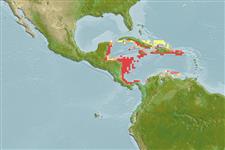Common names from other countries
Environment: milieu / climate zone / depth range / distribution range
Ecologie
; diepteverspreiding 10 - 50 m (Ref. 129097), usually 30 - 36 m (Ref. 129097). Tropical; 22°N - 9°N, 89°W - 65°W
Western Central Atlantic: The Caribbean Sea from Honduras, Greater Antilles, to the north coast of South America.
Length at first maturity / Size / Gewicht / Leeftijd
Maturity: Lm ? range ? - ? cmCommon length : 6.0 cm TL mannelijk/geslacht niet bekend; (Ref. 344)
Shell thin but strong, circular, moderately inflated, inequivalve. Wing-like projections small. Surface smooth, glossy, but internally with 30 to 40 paired radial ribs. Lower (right) valve more convex than upper (left) valve. Hinge straight. Colour: lower valve cream with light brown rays, upper valve reddish brown mottled with white.
Substrate: sandy mud bottoms (Ref. 344).
Life cycle and mating behavior
Geslachtsrijpheid | Voortplanting | Kuitschieten | Eieren | Fecundity | Larven
Members of the class Bivalvia are mostly gonochoric, some are protandric hermaphrodites. Life cycle: Embryos develop into free-swimming trocophore larvae, succeeded by the bivalve veliger, resembling a miniature clam.
Leal, J.H. 2003. (Ref. 344)
Status op de Rode Lijst van het IUCN (Ref. 130435)
Status bij CITES (Ref. 108899)
Not Evaluated
Not Evaluated
Gevaarlijk voor mensen
Harmless
Gebruik door de mens
| FishSource |
Tools
Meer informatie
Leeftijd/GrootteGroeiLengte-gewicht parametersLengte-lengte parametersMorfologieLarvenAbundantie
Internet-bronnen
Estimates based on models
Preferred temperature
(Ref.
115969): 27.5 - 28.2, mean 27.7 (based on 10 cells).
